Funding and Finagling the Transition to Biomass Heat and Power
by Krys Cail
This article follows up on two other recent articles about solid biomass fuel as a source of heat:
(October 2009) Burning Transitions: How Planned, Localized, Sustainable Non-food Biomass Utilization Can Help Ease Energy Descent and Mitigate Global Climate Change [1]
(January 2010) Heating with Biomass in Tompkins County [2]
This installment adds discussion of combined heat and power applications. While continuing to focus on local efforts and local projects, the article also examines the role of local and larger-scale governmental entities in supporting the development of the biomass industry in Tompkins County and considers some roles played by local businesses and nonprofits. Some local demonstration projects that were briefly mentioned in the earlier articles are more fully considered here.
Abbott/Lund Hansen LLC
The U.S., with relatively abundant biomass resources, is far behind some other countries in the use of those resources for heat and power production. This has the perverse effect of encouraging the export of US biomass resources to European countries, where both governments and businesses have embraced the development of technology and infrastructure to accommodate the use of non-fossil fuels for these purposes. Conversely, the technology needed to use North American biomass resources has often had to be imported from Europe.
In any comparison of biomass use across nations, Denmark stands out for the success it has had in weaning itself from a petroleum-dependent infrastructure. The initial motivation for this development was not an abundance of available alternative resources, but, rather, a serious brush with scarcity in the wake of the first oil shock. However, at this point, the success that Denmark has attained in maximizing efficiency in combined heat and power generation is also making Danish technology attractive elsewhere around the world. Recently, a local businessman and real estate developer and a Danish engineer established a new company aimed at emulating the Danish approach to combined heat and power.
In 2010, the new company Abbott/Lund Hansen LLC was formed, joining a Danish district heating specialist with a Tompkins County developer. District heating, as a concept, is the idea of heating a number of adjacent or nearby buildings with one central heating plant. In Denmark, super-efficient heating plants may be operated on biomass fuel (pellets or chips) or traditional fuels like natural gas. Combined heat and power (CHP) is also common in the Danish systems, with the heat that is generated in the course of making electricity for a district captured and used in heating the district. Below is a synopsis of Abbott/Lund Hansen LLC’s work, in the words of its founders.
Bruce Abbott and Thomas Lund Hansen recently formed a marketing and lobbying firm that is advocating for district energy in Tompkins County. A local example of district energy is at Cornell University. In 1888 Cornell built a coal fired steam heat only system for its campus. This year that system has been converted to a natural gas fired steam combined heat and power (CHP) system. Cornell’s CHP system will not only supply heat to buildings on campus but it will supply 80% of Cornell’s electricity needs. The only difference between the Cornell system and the systems that Abbott/Lund Hansen are advocating is that the Cornell system relies on steam and the Abbott/Lund Hansen systems relies on hot water. For the end user, hot water CHP systems are safer, more reliable, and cost less then comparable steam systems.
Combined Heat and Power systems, in general, increase energy efficiency by 30% while decreasing energy cost by 15%. There are other advantages for building CHP systems in Tompkins County. CHP systems can drastically reduce greenhouse gas emissions because they can burn a variety of fuels. For example, using biomass as fuel would reduce [greenhouse gas emissions] to virtually zero for the buildings that are connected to a biomass CHP system. Another advantage CHP systems would have in Tompkins County is that there would be numerous job opportunities building and operating these systems…
Bruce Abbott stresses that the jobs created by district generation/CHP will remain in the local economy and can’t be transferred elsewhere, including the jobs harvesting and manufacturing biomass fuel. The company envisions a number of scenarios under which district generation/CHP could offer the local economy job-creation and economic development benefits. These major building projects require significant capital investment to attain a scale that can realize the efficiencies inherent in their design and reap the employment and economic development benefits. One approach that Abbott has advocated for Tompkins County is to have the AES Cayuga power plant establish and operate these districts in areas where they are practicable, such as the Downtown Ithaca Business District or the South Hill Office Campus. The new company has also suggested that Tompkins County (or the Town or City of Ithaca) might invest in the development of heating districts. The new business, Abbott/Lund Hansen, is also pursuing other opportunities to design these combined heat and power generation districts in the region; it has just signed a contract to do the preliminary design for a biomass (wood-chip) CHP system that will supply the electricity, heat, and air-conditioning for 700,000 square feet of mixed use commercial and residential space in rural Pennsylvania.
It will be interesting to see what types of entities—businesses/developments, educational institutions and other nonprofits, or governmental bodies—will have the vision, the capital and the sites to try this new approach to providing heat and power. The adoption of these highly efficient systems in the private sector can be advanced through governmental incentives to adopt the technology, which is how the Danish system came into being. What is needed is the will to transition, and a plan for accomplishing the switch. Bruce Abbott puts it succinctly:
In summary, moving toward a less costly, local, and reliable energy solution that improves energy security and environmental impact is possible today. What is required is a well-written plan and the political will to put it into practice.
Cayuga Nature Center—Heated by Biomass
Some movement exists in New York State government to subsidize the adoption of biomass heat. The New York State Energy Research and Development Authority (NYSERDA) funded a demonstration project to show how efficient and cost-effective biomass heat can be, right here in Tompkins County at the Cayuga Nature Center. The multi-fuel (woodchip or pellet) boiler used in this conversion to biomass heat was the very first unit produced by a Schenectady firm, ACT Bioenergy[3]. The firm has licensed European multi-fuel boiler technology to produce these units in New York State from all U.S.-made materials.
The 10,000 square foot Cayuga Nature Center lodge houses both educational and administrative offices for the nonprofit organization. Installation of the containerized boiler and adjacent fuel storage areas did not require any construction work or disruption of programs in the program and office space. Existing hot-water radiators were used in the retrofit, and all conversion work was kept in the basement area of the building. The three existing propane boilers were kept in place to act as an emergency back-up system. The fuel and the boiler itself, in its containerized outdoor location, are an additional educational display along a path that also includes other educational exhibits and gorge overlooks used in Nature Center programs.
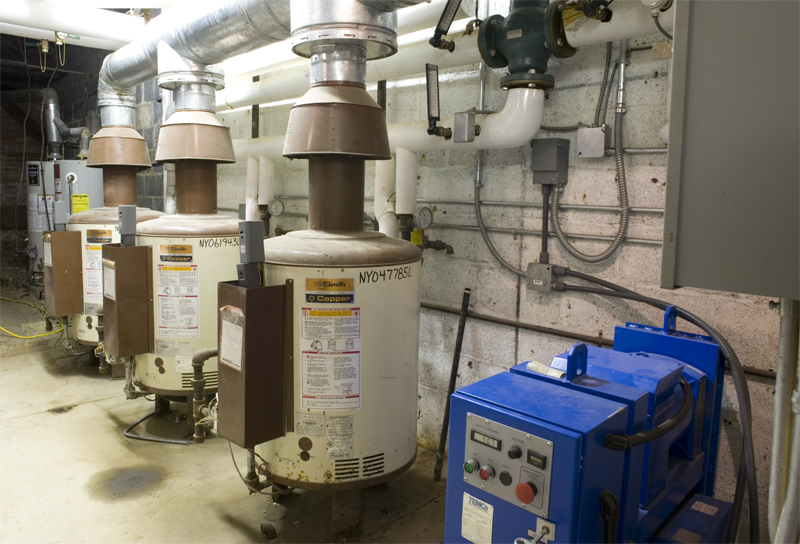
Figure 1. The propane-fired system that formerly heated the 10,000 square foot Cayuga Nature Center. The system is kept on standby as a backup
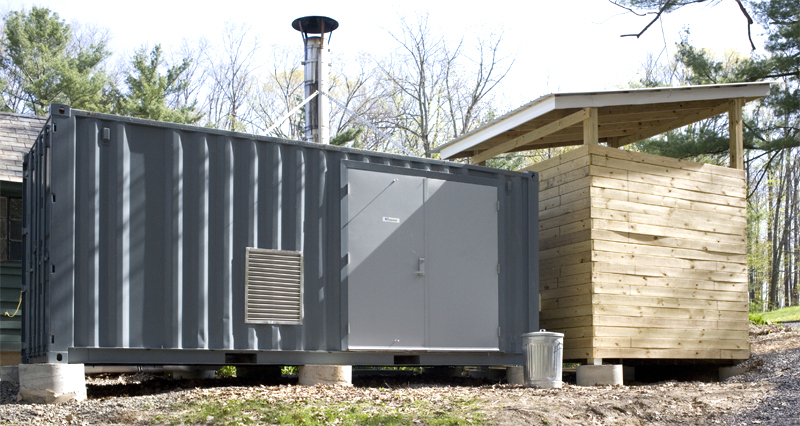
Figure 2. Exterior of new woodchip fired boiler. The wooden feed bin on the right holds about a week's worth of fuel at maximum boiler output. An auger automatically conveys fuel from the hopper to the boiler
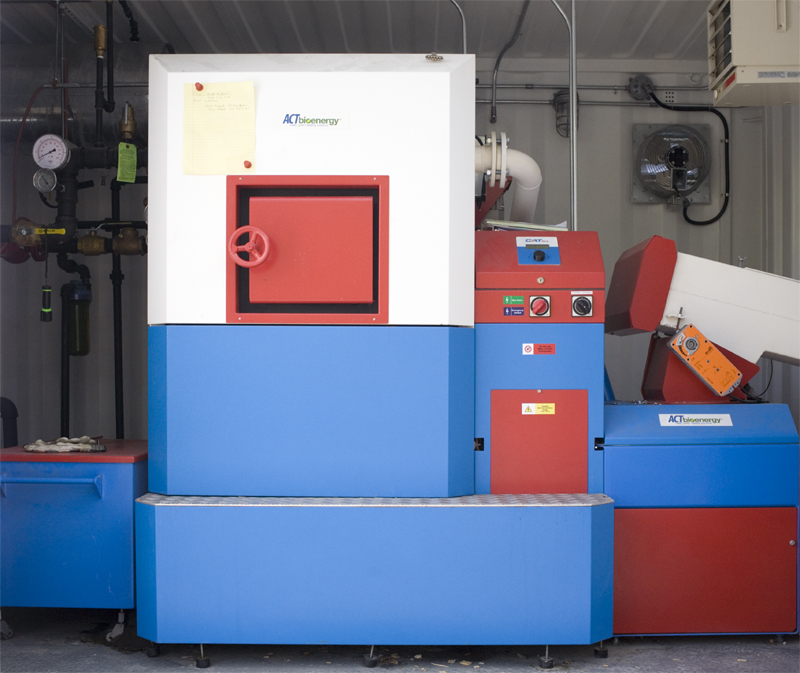
Figure 3. The boiler can produce 400,000 BTU per hour from wood chips
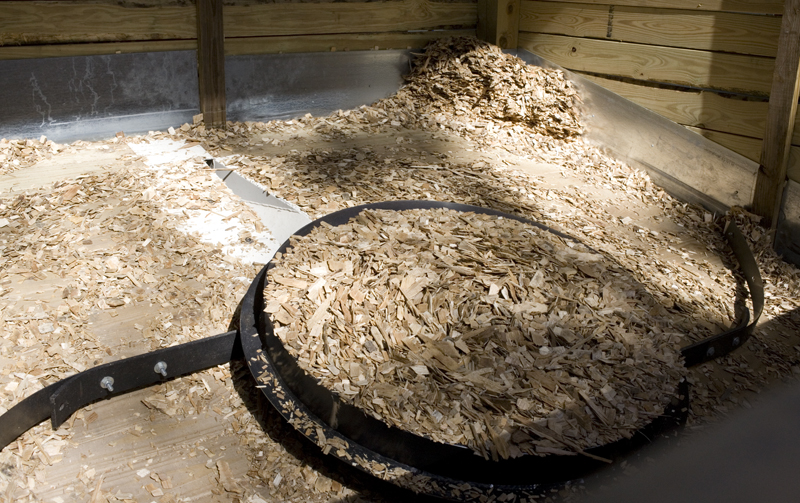
Figure 4. Interior of feed bin (almost empty) showing the sweeper that moves chips across the auger trough
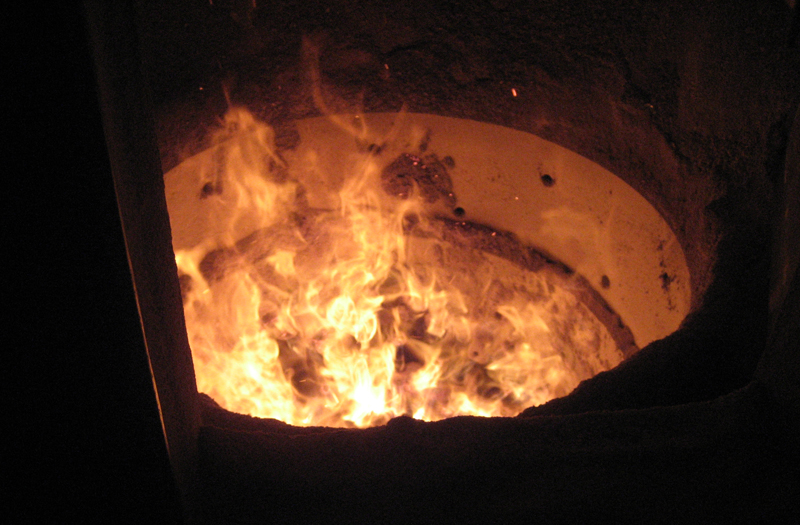
Figure 5. Chips are fed from below to the center of a grate at the bottom of the combustion chamber. Optimal combustion is achieved by controlling the air supplied through holes in the chip bed and holes on the sides of the combustion chamber. The ash produced by this process is less than one percent of the fuel burned
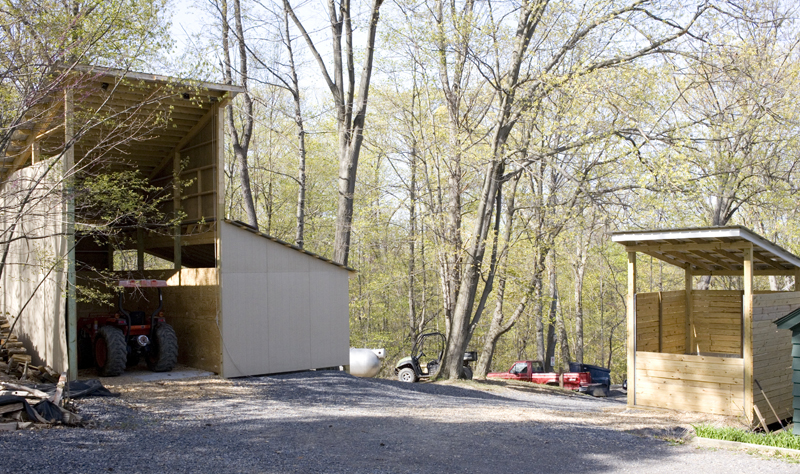
Figure 6. A 12 x 40 foot shed (on the left) stores chips to periodically replenish the feed bin (on the right). The shed was constructed with volunteer help from Cornell Engineers for a Sustainable World
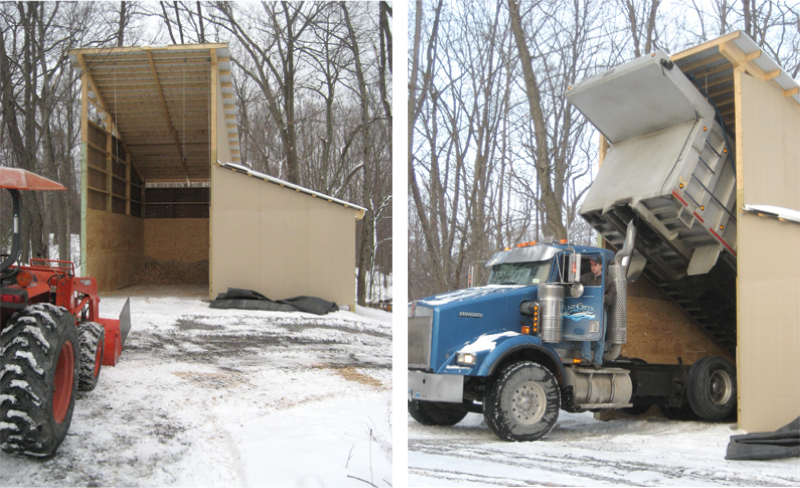
Figure 7. Left: The storage shed in winter and the front loader used to transfer chips to the feed bin; Right: Receiving a 10 ton (50 cubic yard) chip delivery from Mesa Reduction of Auburn, NY. The chips are made from the waste streams of regional lumber mills. In the future, some fuel will come from CNC and other nearby forests
This project would not have been possible without the determined and persistent effort of TC Local contributor and local biomass proponent Tony Nekut. NYSERDA was eager to have a demonstration project, and the Cayuga Nature Center was eager to solve the problem of high propane heat bills, but it took a local activist to bring the need and those with the funding together to make it work. While fuel costs have not yet been tabulated for the year, it is estimated that the new boiler will result in a 50 to 75 percent savings in fuel.
The CNC installation is part of a larger NYSERDA effort to support the evaluation and improvement of biomass-fired heating equipment. According to a recent press release,[4]
The program will clear a path for New York-grown fuels, create new manufacturing jobs, and improve environmental performance of biomass technologies….
ACT’s project at the Cayuga Nature Center in Ithaca, NY, will demonstrate a fully automated, 90 percent efficient wood-gasification boiler technology that is proven in Europe and adapted for the U.S. market. These systems have emissions that are significantly better than conventional wood boilers and comparable to typical oil or gas boilers. Mid-sized buildings (10–100,000 sq.ft.) represent 90 percent of the boiler market in the U.S., and are prime targets for these wood systems which can achieve rapid paybacks when replacing fossil-fuel boilers.
More information on this project is available at http://www.actbioenergy.com/brochure/Cayuga%20wood%20boiler%20photos.pdf
Town of Danby Highway Barns—Project to Retrofit ACT Bioenergy Boiler Using American Reinvestment and Recovery Act (ARRA) Funds
The Town of Danby has a high level of interest in biomass as a heat and energy source. Not only are Town elected officials and staff excited about the potential of making use of a local resource in moving away from fossil fuels, the residents of the Town are also very involved. Citizen involvement is primarily through the Danby Land Bank Cooperative,[5] which “provides an organization and an infrastructure that allows rural property owners to use their fields and forests for grass and wood pellet production.” In the neighboring township of Caroline, Cayuga Biomass Energy, a small group of entrepreneurs that includes TC Local contributor Tony Nekut, is attempting to start a biomass pellet manufacturing plant.
The projected cost to convert the Town’s 10,000 square foot office and truck bay complex to wood chip heat is about $267,000. While the projected fuel cost savings are estimated to be 50 percent or greater, a capital improvement of that scale is difficult for a small rural township to budget or buy bonds for; usually, help from a higher level of government is needed for improvements on this scale. In this case, the Town administration decided to pursue funding under the American Reinvestment and Recovery Act (ARRA)-the federal stimulus package.
As in the Cayuga Nature Center project, biomass proponents helped to bring the need and the source of funds together—in this case, Tony and I helped the Town of Danby make application for these funds by coordinating grant-writing and project specification tasks.[6] In March of 2010, NYSERDA awarded these federal funds to Danby. For its part in the project, the Town will contribute some highway worker hours to the excavation and concrete work needed to construct a covered fuel storage area. The boiler unit, which is almost identical to the one in use at Cayuga Nature Center, will be installed by a regional heating contractor, and the jobs producing biomass fuel will be hyper-local—ideally, in Danby or adjoining Caroline. In fact, the Town Highway crews plan to produce some of the wood chip fuel themselves in the process of keeping the roadways clear. This is a good use of a federal program aimed at maintaining and creating jobs in economically distressed counties like Tompkins.
RPM Ecosystem’s Combined Heat and Power Project/Biomass Demo Plantations
PJ Marshall, one of the principals of RPM Ecosystems[7], wanted to provide the heat and power to operate the firm’s Town of Dryden greenhouses and company headquarters while remaining carbon-neutral. And she wanted to do so using only the products RPM grows—native hardwood trees. Additionally, she sought to develop and demonstrate a biomass plantation system using native hardwood trees planted specifically for a combination fuel/lumber harvest, staged to produce first fuel wood and then lumber, over a number of years, while maximizing forest canopy and carbon sequestration throughout the process. RPM pursued this plan through local Congressman Michael Arcuri, looking to secure a federal appropriation to fund the project.
The company made good progress in developing the project and getting the appropriation drafted last year (2009) but then encountered difficulties when Congress passed a rule requiring that no appropriations go directly to private companies. RPM regrouped and engaged TCAD[8] as a fiscal sponsor for the projects. Heather Filiberto, Director of Economic Development Services at TCAD, describes the agency and its role in the project this way:
TCAD, the County’s lead economic development agency, is a non-profit organization whose mission is to build a thriving and sustainable economy that improves the quality of life in Tompkins County by fostering the growth of business and employment. In situations in which governmental funding must be received by a non-profit, TCAD has stepped in and sponsored applications on behalf of local entrepreneurs in the past. TCAD has agreed to sponsor this request for federal funding on behalf of RPM.
In order to succeed in getting an appropriation in the federal budget for a project, the applicants must obtain letters of support from a wide variety of local officials. The typical support letter is prepared by the applicant in overall substance, then transferred to letterhead and signed by the various elected officials with only slight modifications. The projects are briefly described along with the expected benefit to the community. The following excerpt, from Senator James Seward’s letter, demonstrates the approach.
I am writing to express my strong support for Tompkins County Area Development and RPM Ecosystems Ithaca LLC’s, innovative Dryden, New York, green building and renewable energy project titled Distributive Biomass Combined Heat and Power for CO2-Neutral Facility Operations….
…this project helps install and commission a 200KWe distributive biomass combined heat and power set for sustainable/renewable electricity and thermal energy production in support of RPM Ecosystems Ithaca LLC’s operations.…
TCAD, RPM Ecosystems, and Congressman Arcuri are all hopeful that the funding for this project will be included in this year’s federal budget. Still, the project must wait to commence until the political process runs its course.
Individual Homeowners Can Access Governmental Biomass Incentives
Some government-assisted financing options exist for individual homeowners interested in converting some or all of the heat or hot water produced in their homes to biomass fuels. Anyone who is in a position to benefit from a tax incentive can receive up to 30 percent of the cost of a pellet stove (not to exceed $1,500) in tax savings. A website is available to help with determining whether this program meets your needs,[9] or contact the Pellet Fuels Institute.[10] Local pellet stove merchants can also assist in understanding the program and which units qualify. Unfortunately, stoves and furnaces that burn cordwood are not eligible for these incentives.
NYSERDA also has some homeowner financing programs[11] for the installation of a pellet stove and for the energy efficiency retrofits that can be accomplished in conjunction with a transition to a heat source based on certain kinds of renewable fuel. In general, cordwood stoves and furnaces are ineligible for these programs. For homeowners with low or moderate income, low-interest financing programs, and even some grants, are available through Ithaca Neighborhood Housing Services.[12] Similar programs are available through Tompkins Community Action,[13] and some similar services may be available through Better Housing for Tompkins County[14] as a part of home rehabilitation. All of these housing agencies should be contacted to determine what programs might work best for your individual needs.
Most programs will require that you obtain a professional energy audit to determine which energy improvements may be most cost-effective for you. Even if you don’t use an incentive program, an energy audit can help you to tackle energy investments in the order that gives you the most benefit for the money invested. Conservation measures and efficiency upgrades are often more cost-effective than investing in a renewable fuel heat source. The housing agencies linked above can provide referrals for homeowners of all incomes to qualified energy audit providers and Building Performance Institute (BPI) certified contractors. In most cases, only BPI-certified contractors are eligible to perform work that will qualify for incentives. These energy auditors and BPI-certified contractors are also trained to make use of up-to-date methods and products for saving energy and using renewable fuels.
Funding and Finagling: Negotiating the Political Process to Transition to Biomass
Local, state, and federal governments are involved in energy policy and the implementation of energy projects in a number of different and evolving ways. Even a very savvy and motivated community such as Tompkins County may find it difficult to work the system well enough to get sufficient funding and financing for transitions to carbon-neutral and renewable fuel sources. Over time, government-funded energy efforts at conservation, which should always be the first step in a sustainable energy plan, have become institutionalized in a way that makes them more accessible to homeowners, businesses, and other community institutions. However, renewable energy conversions remain new enough that the path to government sponsorship is not always clear-in both the sense of “visible” and “free of obstructions.”
Some motivated activists claim that the slow grinding of the gears in the public sector is not worth the patience to accommodate. The fastest and best approach when projects are low-tech and inexpensive may be a community barn-raising kind of effort. However, commercial-scale projects in large buildings, or the highly efficient district heat and power systems that group many buildings in a densely developed area on one heating system, can’t easily be accomplished via small-scale community efforts. Both funding and implementation will typically require some level of governmental assist or substantial private investment of capital.
How do thinkers, planners, and activists work most effectively to bring about a transition away from fossil fuel dependence? Understanding the ways that the layers of government divvy up responsibility, and how they do and don’t collaborate, is an important place to start when developing a strategy.
Planning efforts go on at all levels of government—federal, state, regional, county, and municipal. Professional planners are often those who elected officials turn to for information and explanation of policy options, even though elected officials themselves enact policy. It is productive to educate both planners and elected officials about new policies on renewable energy enacted by other governments and to call their attention to demonstrations of new technology. By definition, planners are charged with taking the long view of our situation, and may be the first to show interest in emerging technology and trends. Eventually, however, elected officials must choose to implement new projects.
Those of us, planners or otherwise, who take a long view of our local adjustment to energy descent may consider funding for transitions away from dependence on fossil fuel to be one of the most vital things our governments can do to assure our future security. Implementing that transition can be accomplished by educating elected officials and the professional planners who advise them, and also by applying for and using the funds (grants and capital) and financing (low-interest loans and tax-exempt bonds) for the purpose when such are available. The process is likely to be difficult, even frustrating at times. To lead the way to a renewable-fuels future, we should focus on creating the will, knowledge, and capacity to make good use of every opportunity for implementing projects. The more we show each other how to heat with renewable fuels, the more examples of successful projects will be available to help others understand the benefits. Eventually, we will reach a tipping point at which the logic of using sustainable, renewable sources for our heat and power will make more sense than fighting one another for a rapidly-diminishing stock of polluting fossil fuels.
Notes
[1] http://tclocal.org/2009/10/burning_transitions.html
[2] http://tclocal.org/2010/01/heating_with_biomass_in_tompki.html
[3] http://www.actbioenergy.com/
[4] http://www.actbioenergy.com/news.html#
[5] http://www.danbylandbank.com/site/home.html
[6] Contact Tony Nekut or Krys Cail through the comments section linked to this article if your Tompkins County municipality or school district is interested in pursuing biomass heat funding; we are interested in sharing information.
[7] http://www.rpmecosystems.com/
[9] http://energytaxincentives.org/consumers/heating-cooling.php
[10] http://www.pelletheat.org/3/residential/taxCredit.html
[11] http://www.getenergysmart.org/SingleFamilyHomes/ExistingBuilding/HomeOwner/Financing.aspx
[12] http://www.ithacanhs.org/pdf/LendingServicesWeb020210.pdf
Categories
energy production , investment
